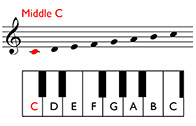5.2 Semitones and tones, and the scale of C major
If we take a section of the complete range of notes we named, starting at middle C and proceeding up to one of the other Cs, we have the ascending scale of C major (Example 41).
Example 41

Visually, the steady progression of the note heads climbing up the staff suggests that the note heads and the sounds that they signify are equidistant from each other. This idea seems reinforced if you play the scale on a keyboard – you simply play up the white notes from middle C up to the next C.
However, you will spot immediately from Example 42 that there are black notes on the keyboard as well as the white ones. You will also notice that although these are set back from the white ones, they alternate with the white ones, or at least do so for much of the time.
Example 42

For instance, you can see from Example 42 that there is a black note between the C and the D, and then another one between the D and the E. But there isn’t one between the E and the F. As we shall see in a moment, this is crucial.
The distance between two notes is called an interval, and the interval between the C and the black note set slightly back and to its right is a semitone. The interval between this black note and the D is also a semitone. Two semitones add up to a larger interval, called a tone, and so, because we have gone up two semitones in total, the interval between C and D is a tone. The interval between D and E is also a tone – we’ve seen that there is also a black note set between these two notes. However, between E and F there is no black note, and so the interval here is only a semitone.
If we now continue up the scale to the next C, we can identify the intervals between each pair of notes:
| C–D | Tone | |
| D–E | Tone | |
| E–F | Semitone | no black note in between |
| F–G | Tone | |
| G–A | Tone | |
| A–B | Tone | |
| B–C | Semitone | no black note in between |
This pattern of tones and semitones – we can represent it symbolically as T T S T T T S – provides the structure of the C major scale, and all major scales. It is therefore a good idea to memorise this structure (which is called the intervallic structure of the major scale).
